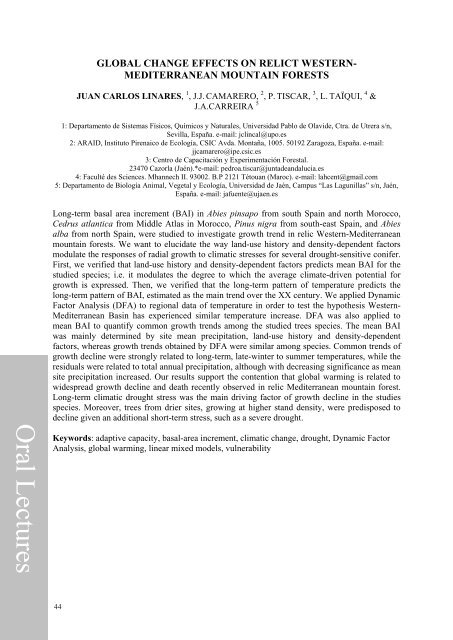Adil GÜNER, Vehbi ESER - optima
Adil GÜNER, Vehbi ESER - optima
Adil GÜNER, Vehbi ESER - optima
You also want an ePaper? Increase the reach of your titles
YUMPU automatically turns print PDFs into web optimized ePapers that Google loves.
Oral Lectures<br />
44<br />
GLOBAL CHANGE EFFECTS ON RELICT WESTERN-<br />
MEDITERRANEAN MOUNTAIN FORESTS<br />
JUAN CARLOS LINARES, 1 , J.J. CAMARERO, 2 , P. TISCAR, 3 , L. TAÏQUI, 4 &<br />
J.A.CARREIRA 5<br />
1: Departamento de Sistemas Físicos, Químicos y Naturales, Universidad Pablo de Olavide, Ctra. de Utrera s/n,<br />
Sevilla, España. e-mail: jclincal@upo.es<br />
2: ARAID, Instituto Pirenaico de Ecología, CSIC Avda. Montaña, 1005. 50192 Zaragoza, España. e-mail:<br />
jjcamarero@ipe.csic.es<br />
3: Centro de Capacitación y Experimentación Forestal.<br />
23470 Cazorla (Jaén).*e-mail: pedroa.tiscar@juntadeandalucia.es<br />
4: Faculté des Sciences. Mhannech II. 93002. B.P 2121 Tétouan (Maroc). e-mail: lahcent@gmail.com<br />
5: Departamento de Biología Animal, Vegetal y Ecología, Universidad de Jaén, Campus “Las Lagunillas” s/n, Jaén,<br />
España. e-mail: jafuente@ujaen.es<br />
Long-term basal area increment (BAI) in Abies pinsapo from south Spain and north Morocco,<br />
Cedrus atlantica from Middle Atlas in Morocco, Pinus nigra from south-east Spain, and Abies<br />
alba from north Spain, were studied to investigate growth trend in relic Western-Mediterranean<br />
mountain forests. We want to elucidate the way land-use history and density-dependent factors<br />
modulate the responses of radial growth to climatic stresses for several drought-sensitive conifer.<br />
First, we verified that land-use history and density-dependent factors predicts mean BAI for the<br />
studied species; i.e. it modulates the degree to which the average climate-driven potential for<br />
growth is expressed. Then, we verified that the long-term pattern of temperature predicts the<br />
long-term pattern of BAI, estimated as the main trend over the XX century. We applied Dynamic<br />
Factor Analysis (DFA) to regional data of temperature in order to test the hypothesis Western-<br />
Mediterranean Basin has experienced similar temperature increase. DFA was also applied to<br />
mean BAI to quantify common growth trends among the studied trees species. The mean BAI<br />
was mainly determined by site mean precipitation, land-use history and density-dependent<br />
factors, whereas growth trends obtained by DFA were similar among species. Common trends of<br />
growth decline were strongly related to long-term, late-winter to summer temperatures, while the<br />
residuals were related to total annual precipitation, although with decreasing significance as mean<br />
site precipitation increased. Our results support the contention that global warming is related to<br />
widespread growth decline and death recently observed in relic Mediterranean mountain forest.<br />
Long-term climatic drought stress was the main driving factor of growth decline in the studies<br />
species. Moreover, trees from drier sites, growing at higher stand density, were predisposed to<br />
decline given an additional short-term stress, such as a severe drought.<br />
Keywords: adaptive capacity, basal-area increment, climatic change, drought, Dynamic Factor<br />
Analysis, global warming, linear mixed models, vulnerability<br />
32






